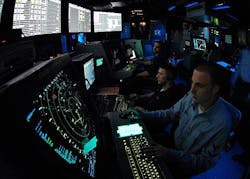GTS to provide Navy with more rugged water-cooled shipboard computers in $10.6 million deal
Officials of the Naval Sea Systems Command in Washington are asking GTS to build 20 technical insertion 12 hybrid (TI-12H) AN/UYQ-107 common processing system (CPS) water-cooled production units. The CPS is a rugged shipboard computer processing system based on an open-architecture design.
The order will provide for production, testing and delivery of water-cooled, air-cooled, and air-cooled commercial-equivalent CPS systems, as well as spare parts and engineering services.
The CPS provides a common computing infrastructure for ship combat systems, including processing and memory, data storage and extraction, and I/O interfaces for combat systems. The GTS team building the CPS consists of Northrop Grumman, DRS Technologies, IBM, and GoAhead Software, which has been acquired by Oracle Corp. in Redwood City, Calif.
Related: Navy chooses rugged embedded computers from Ballard Technology for LCS ship modules
Earlier this month GTS won a $63.2 million Navy order for additional CPS production. The CPS and Common Display System (CDS) programs provide replacements for obsolete shipboard display and processing equipment like AN/UYQ-70 for warfare systems aboard Navy aircraft carriers, amphibious assault ships, cruisers and destroyers.
CPS provides the computer processing, memory, data storage, and I/O interfaces to support Navy combat system software applications and computers in Aegis Modernization, Aegis new construction, Surface Electronic Warfare Improvement Program (SEWIP), and other Navy programs.
GTS engineers build the CPS using commercial off-the-shelf (COTS) hardware and software such as BladeCenter technology that supplies common infrastructure for processing and network fabric. Plug-in components are accessible, hot-swappable, and battle-ready protected by the GTS Advanced COTS Enclosure (ACE).
The CPS consists of a rugged enclosure and three subsystems: the processing subsystem, the storage and extraction subsystem, and the I/O subsystem.
Related: Waterproof computer for ship, aircraft, and land-based applications introduced by Crystal
The processing subsystem provides the computing resources to execute combat system application programs on Navy surface ships. The storage and extraction subsystem provides data storage for CPS operating system (OS) image storage, program storage, data extraction, and database management. The I/O subsystem, meanwhile, interfaces the processing and storage hardware to various external elements.
Oracle provides for the Common Processing System open-standard middleware, designated SAFfire, for the CPS to support high-availability management of mission-critical combat system. SAF stands for Standards Availability Forum, an industry consortium of companies that develop open standards-based products. The new-generation Open-SAFfire middleware uses open-source technology based on SAF standards.
The overall CPS is designed with a shock-isolating enclosure that protects unhardened COTS components from the intense shock and vibration that can occur on Navy surface ships -- including hits from missiles and torpedoes. The CPS comes in air- and water-cooled versions.
On this order GTS will do the work in Virginia Beach, Va., and should be finished by July 2018. For more information contact Global Technical Systems online at http://gts.us.com, or Naval Sea Systems Command at www.navsea.navy.mil.
Ready to make a purchase? Search the Military & Aerospace Electronics Buyer's Guide for companies, new products, press releases, and videos
